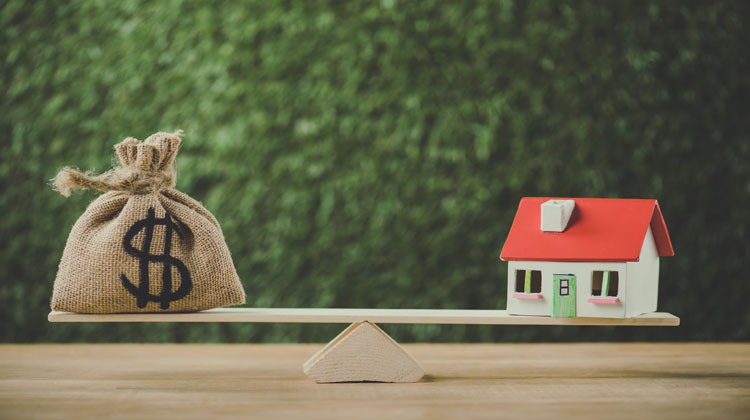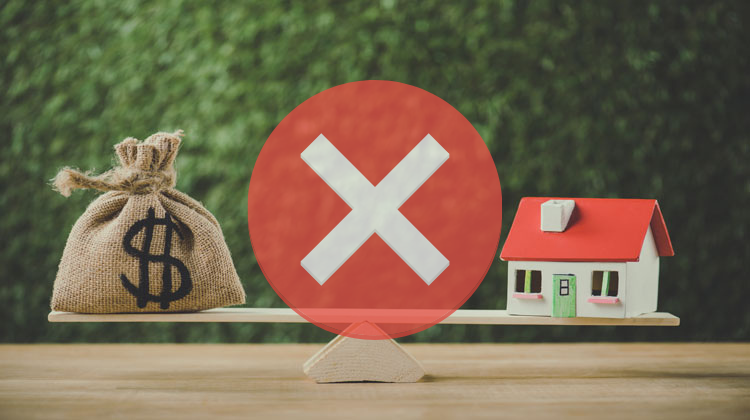THIS POST MAY CONTAIN AFFILIATE LINKS. PLEASE SEE MY DISCLOSURES. FOR MORE INFORMATION.
There are a lot of things to think about when you are considering taking out a mortgage.
How long do you want to be paying it off?
What kind of interest rate can you get?
And should you go with a 15 or 30-year mortgage?
In this post, I’ll walk you through the pros and cons of a 15 year mortgage.
In the end, you’ll have a better idea if this type of mortgage is right for you.
Table of Contents
11 Pros And Cons Of A 15 Year Mortgage
Pros Of A 15 Year Mortgage

There are lot of advantages of a 15-year mortgage.
Here the biggest one to consider.
#1. Pay Off Mortgage Faster
When compared to a 30-year loan, the biggest advantage of a 15-year loan is that you will be able to pay off the loan faster.
At least 15 years faster to be exact.
This is because you are taking the loan and shortening the payback period.
The result of this is a higher monthly mortgage payment, which I’ll get into later.
If your goal is to be mortgage free as soon as possible, then a 15 year mortgage is a good option for you.
#2. Save Thousands In Interest
Another benefit is you will pay thousands less of interest over the life of the loan.
This is due to the fact that you only have half the number of payments you need to make.
For example, let’s say you are taking out a $200,000 loan amount at 3.5%.
If the loan is for 30 years, you will pay $123,312 in interest, assuming you don’t make any extra payments.
But if you take out the loan for 15 years, you will pay $57,357 in total interest costs.
That is a savings of close to $66,000.
Re-read that again.
With mortgages, you pay mostly interest in the beginning of the loan and mostly principal at the end.
By having a 15-year term, you pay the principal balance back sooner, saving you money in interest charges.
#3. Build Equity Faster
If your goal is to build equity as fast as possible, you do this best with a 15 year mortgage.
Again, this is because you pay back more principal sooner when compared to a 30 year mortgage.
Let’s look at an example.
We will use a $200,000 loan at 3.5% again.
On at 30 year mortgage, after 10 years, you still have $154,853 in principal to pay.
On a 15 year mortgage, after 10 years, you only have $78,594 in principal to pay.
With more equity, if you sell, you can walk away with more money.
Or if you want to do home projects, you can tap the extra equity as well.
#4. Forced Savings
It’s no secret the Americans are horrible at saving money.
In fact, the average savings rate has hovered between 6-7% the past few years.
By taking out a mortgage with a shorter repayment time frame, you will build equity up faster, which is a forced way to save money.
While you would have to tap into this equity to be able to use it, it is still an asset on your balance sheet.
#5. Lower Interest Rate
Because you are taking a shorter term home loan, the interest rate will be less than the same amount borrowed on a 30 year note.
This is because the bank will be getting its money back faster.
There is a lot less risk to the bank to lend money for 15 years versus 30 years.
As a result, 15-year mortgage rates are lower than longer term loans, which have higher interest rates.
Combine the longer term with a higher interest rate and there is a big difference with the total amount you need to pay back the loan when looking at these two loan types.
Cons Of 15-Year Mortgage

While there are many benefits of a 15 year mortgage, there are drawbacks to consider.
Here are the biggest ones to think about.
#1. Larger Monthly Payment
The biggest drawback of a 15 year mortgage is bigger monthly mortgage payments.
When you shorten the amount of time you pay the loan back, your payments will increase as a result.
Looking back at our $200,000 loan at 3.5% example, the monthly payment on the 30 year loan is $898.
Those same terms on a 15 year loan is $1,429.
Depending on your financial situation, the larger payments might make the shorter mortgage not possible for you.
#2. Forced To Buy A Smaller Home
Because of higher monthly payments, if you are set on a 15 year loan, you might have to buy a smaller house as a result.
Using the example above, let’s say the maximum you could put towards your monthly payments is $1,100 a month.
In this case, the most you could borrow for 15 years is $154,000.
So you have two options.
The first is you look for homes that cost less money to buy, or you need to come up with extra money for a down payment.
Assuming you were putting down 20% on the house with a $200,000 loan, you would need to come up with $96,000 as your down payment.
Otherwise, your monthly budget might not be able to handle your mortgage and your other monthly bills.
And if you don’t put 20% down, you have to remember that you will be required to pay private mortgage insurance until you build enough equity in the property.
#3. Paying A Low Interest Debt
Another downside is a mortgage is typically considered good debt.
This is because even though you have a monthly obligation, the underlying asset is growing in value.
Unlike a car that loses value every year, your house increases in value.
On top of this, you get a tax break on the loan, as you get a mortgage interest deduction on your tax return.
This effectively lowers the interest rate of your loan.
- Read now: Learn how to save on your taxes like the wealthy
- Read now: Discover the differences between tax credit vs. tax deduction
Because of this, many financial experts recommend you take your time paying off your mortgage.
For example, let’s say after taking into account your taxes, the 3.5% interest rate you are paying is effectively 2.5%.
There are a lot of examples of where you can put your money that will grow at a rate higher than 2.5%.
In other words, you could get farther ahead financially by taking out a 30 year mortgage, making the minimum payments and investing the difference.
Here is a very basic example to help you understand this idea better.
The monthly payment of the 15 year mortgage is $898 and the monthly payment of the 30 year mortgage is $1,429.
If you take out the 30 year loan and invest the difference of $531 every month for 15 years earning 8% annually, you end up with $186,854.
This is almost the entire value of the loan you took out.
#4. Opportunity Cost
Related to the above idea is opportunity cost. This is the cost of the decisions you make.
For example, if you decide to buy a new pair jeans, the opportunity cost is you could have used the money to pay off some debt.
But it isn’t just money related.
All decisions have an opportunity cost.
If you stay up late to watch a movie, the cost is less sleep that night and feeling tired the next day.
The point here is if you go with the shorter loan, you are putting more of your money towards your house.
What are you giving up for doing this?
Maybe you have to save less for retirement?
Or maybe you have to put off saving for a vacation?
While the idea of having your house paid off in 15 years sounds great, you have to weigh the impact it will have on your finances.
#5. Cash Poor
Another drawback is the concept of being cash poor.
You might have heard this as “house rich, cash poor”.
What this means is that all your money is tied into one asset, you house.
Because most of your monthly income is going towards your mortgage payment, you can’t save any money.
So when your house is paid off, if you calculate your net worth, it may show a nice high number.
But looking closely at it shows that you have no money saved in your retirement account, you have no money in an emergency fund, and you have no savings at all.
- Read now: Here is how to calculate your net worth
- Read now: Click here to see how to build your emergency fund fast
All your wealth is your house, so you are house rich and cash poor.
To be fair, you could end up the same way even with a 30 year mortgage if you take out a loan for the maximum amount you can afford.
But it is something you have to consider.
#6. Lack Of Freedom
When you take out a shorter term loan, you have to make the higher payment.
But if you took out a longer term loan, you would have lower monthly payments and more freedom to pay more.
For example, let’s say you took out a 30 year mortgage.
There is no reason why you have to take 30 years to pay it back.
You could choose to make extra payments and retire the loan in 20 years or less.
This flexibility allows you to pay extra when you have more income and you can make the lower payments if you have times where money is tight.
Final Thoughts
At the end of the day there are pros and cons to a 15 year mortgage.
You have to decide which is right for your life and financial goals.
While paying off your house in this shorter period of time is great, it isn’t if it causes stress in your life and forces you to go without things.
Or it makes you house rich and money poor.
Take the time to consider your financial picture, not only now, but in the future if you take out this loan.
Finally, consider bad things that might happen, like need to replace the roof or other repairs and make sure you can afford these things with the higher payment amount.
The last thing you want is to make a decision that makes money so tight you have to go into credit card debt just to get by.
- Read now: See the pros and cons of buying vs. renting
- Read now: Here are Dave Ramsey’s Baby Steps for fixing your finances
- Read now: Discover the trick to never have a car payment again
I have over 15 years experience in the financial services industry and 20 years investing in the stock market. I have both my undergrad and graduate degrees in Finance, and am FINRA Series 65 licensed and have a Certificate in Financial Planning.
Visit my About Me page to learn more about me and why I am your trusted personal finance expert.
